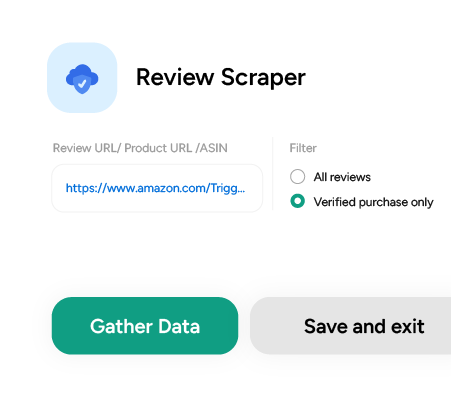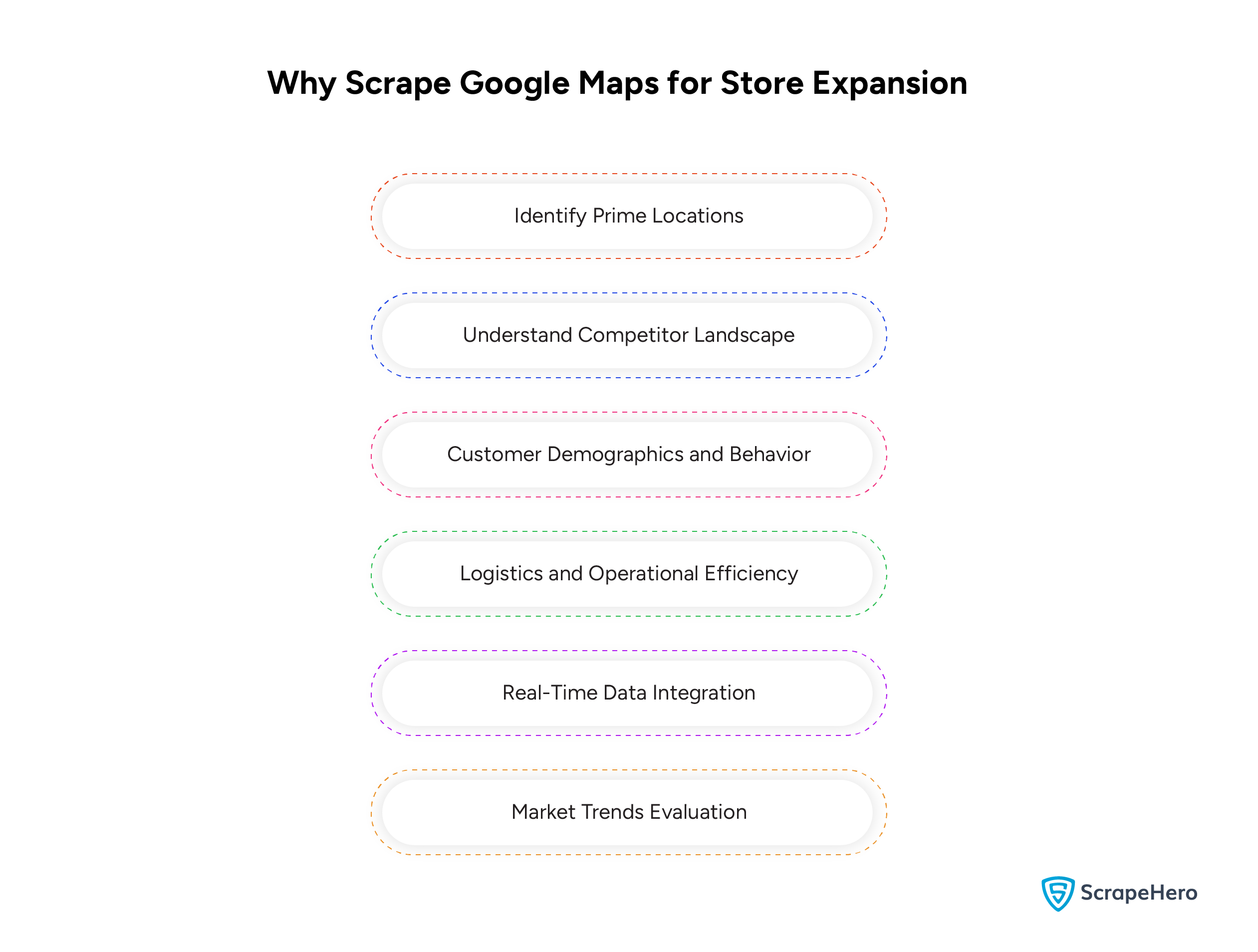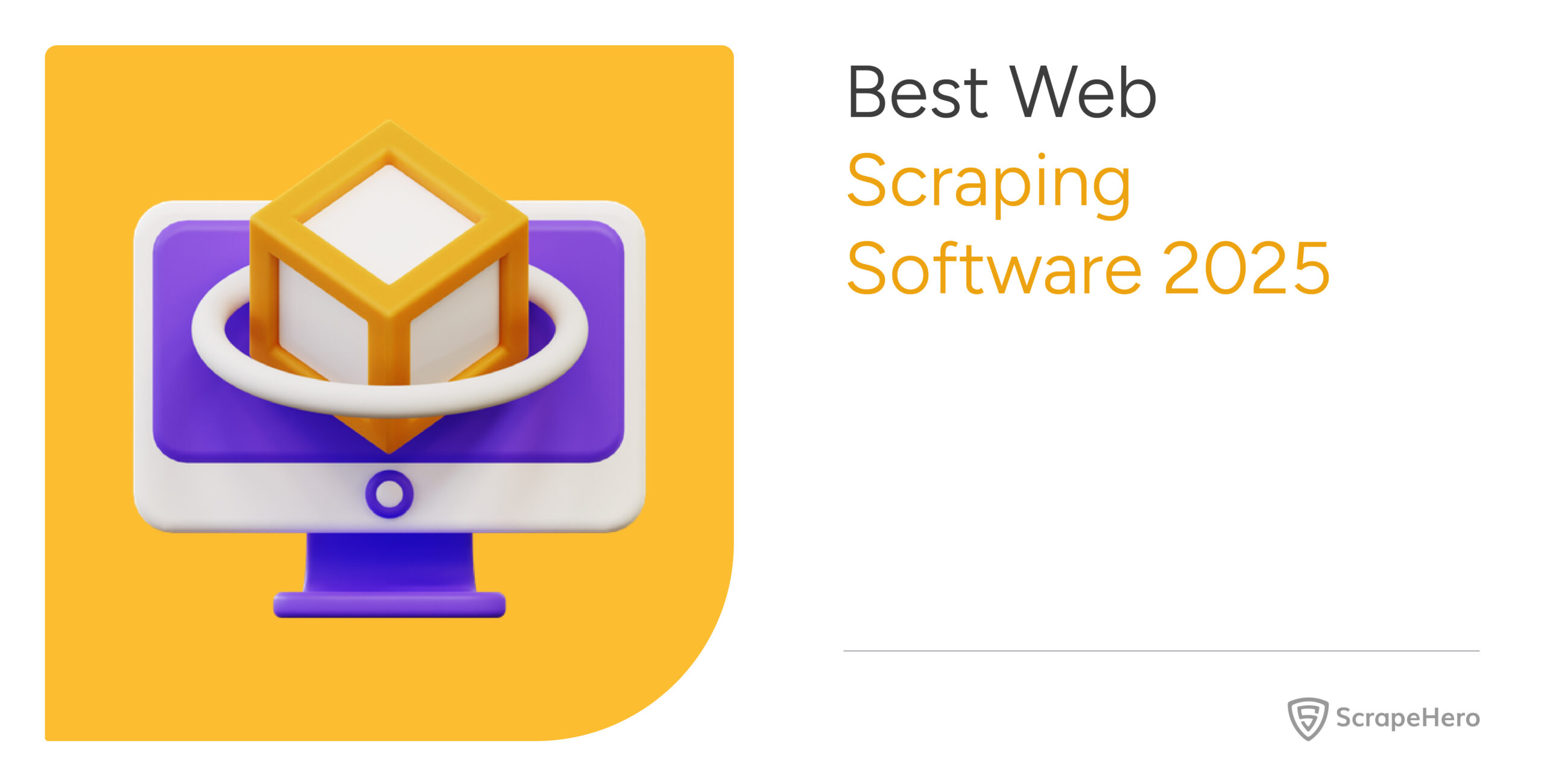Did you know you could scrape Google Maps for store expansion?
Well, you can, and you should.
Finding the right spot for your store is no child’s play. You need to do the research to ensure that you are located in an accessible location with great foot traffic and visibility.
So, the time you spend on making it right is you adding to the overall success.
Continue reading to understand how scraping Google Maps can be a game changer in your store expansion process. Also, learn how to do it best.
Want to try scraping Google Maps by yourself? Try the ScrapeHero Google Maps Scraper and scrape 25 pages for free.
With ScrapeHero Cloud, you can download data in just two clicks!Don’t want to code? ScrapeHero Cloud is exactly what you need.

Why Scrape Google Maps for Store Expansion
While the average person understands Google Maps as a navigational tool, from a business perspective, it is much more than that.
Explained below are the different ways in which Google Maps data can help in the store expansion process of a business:
- Identifying Prime Locations
- Understanding Competitor Landscape
- Customer Demographics and Behavior
- Logistics and Operational Efficiency
- Real-Time Data Integration
- Market Trends Evaluation
Identifying Prime Locations
By scraping Google Maps, businesses can gather data to identify high-traffic locations that align with their target market.
This includes analyzing foot traffic patterns, nearby amenities, and demographic information, which helps in selecting optimal sites for new stores.
For example, a coffee shop might find that a new shopping district has high foot traffic, making it an ideal spot for a new location.
Understanding Competitor Landscape
Access to competitor information is crucial for successful business expansion.
Scraping Google Maps allows businesses to locate where competitors are located, assess their market share, and identify gaps in the market.
This competitive analysis can help decide where to open new locations.
For instance, a clothing store can identify that there are few competitors in a particular neighborhood and fill that gap to attract customers looking for options.
Customer Demographics and Behavior
Google Maps data scraping can provide data that can be analyzed to gain insights into local demographics and consumer behavior.
With this information, businesses can better understand their potential customer base in different regions. This allows them to tailor their offerings and strategies to meet local preferences.

Logistics and Operational Efficiency
Scraping real-time traffic data helps businesses optimize delivery routes and manage logistics more effectively.
Understanding traffic patterns allows for better planning of store operations reducing delivery times and costs, which are important in ensuring customer satisfaction.
Real-Time Data Integration
Scraping Google Maps allows businesses to use up-to-date information in their decisions. They can quickly change plans based on current traffic or customer trends.
Evaluating Market Trends
By regularly scraping Google Maps data, businesses can keep an eye on changes in shopping behavior and market trends. This helps them adjust their expansion plans as needed.
What Data on Google Maps Help in Store Expansion
To effectively utilize Google Maps data for store expansion, businesses should focus on scraping the following types of information:
- Business Listings
- Customer Reviews and Ratings
- Popular Times
- Nearby Amenities
- Geographic Coordinates
- Traffic Information
- Store Hours and Accessibility
Business Listings
- What to Scrape: Names, addresses, phone numbers, and website links of local businesses.
- Example: A retail chain can gather a list of competitors in a specific area to analyze their presence and market share.
Customer Reviews and Ratings
- What to Scrape: Customer reviews, ratings, and feedback on local businesses.
- Example: A restaurant could analyze reviews of nearby eateries to identify customer preferences and areas for improvement in their own offerings.
Popular Times Data
- What to Scrape: Information about when businesses are busiest throughout the week.
- Example: A coffee shop can use this data to determine peak hours and adjust staffing accordingly to improve customer service.
Nearby Amenities
- What to Scrape: Information about nearby attractions, schools, parks, and shopping centers.
- Example: A new clothing store might look for locations near schools or universities to target a younger demographic.
Geographic Coordinates
- What to Scrape: Latitude and longitude data for precise location mapping.
- Example: A delivery service can use geographic coordinates to optimize routes based on store locations and customer addresses.
Traffic Information
- What to Scrape: Real-time traffic conditions and patterns in specific areas.
- Example: A logistics company can analyze traffic data to plan efficient delivery routes, minimizing delays.
Store Hours and Accessibility Information
- What to Scrape: Operating hours, and accessibility options offered by local businesses.
- Example: A pharmacy can ensure they are open during peak hours when customers are most likely to visit.
Why Would a Web Scraping Service Be Better at Google Maps Data Scraping
While it’s possible to scrape Google Maps data manually using tools like Selenium or Puppeteer, there are several advantages to using a professional web scraping service:
Efficiency and Speed
Web scraping services have optimized processes and infrastructure to scrape data quickly and efficiently.
They can handle large volumes of scraping tasks simultaneously, saving time compared to manual scraping efforts.
Data Accuracy
Professional scraping services employ advanced techniques to ensure the accuracy and completeness of the scraped data.
They can handle dynamic content, pagination, and other challenges without you having to worry about it.
Reliability
Reputable web scraping services have robust systems in place to handle failures, retries, and other issues that can disrupt scraping. They provide reliable data delivery even at scale.
Compliance
Scraping Google Maps data requires adhering to terms of service and other legal considerations.
Web scraping services are well-versed in these requirements and can scrape data compliantly to avoid issues.
Scalability
As your data needs grow, a web scraping service can easily scale up to handle increased volumes. They have the infrastructure and expertise to adapt to changing requirements.
Expertise
Web scraping services have deep technical expertise in areas like browser automation, IP rotation, and data extraction. They can handle complex scraping tasks that may be difficult for non-experts.
Reduced Overhead Expenses
By outsourcing scraping to a service, you avoid the overhead expense of setting up and maintaining your own scraping infrastructure. This can save significant time and money.
Scrape Google Maps for Store Expansion with ScrapeHero
In addition to the above-mentioned benefits, the following are the features that make ScrapeHero stand out from the rest.
- Reasonable pricing: We offer an affordable On Demand plan for those with only a single-time data requirement.
Our monthly subscription plans provide the cheapest per-unit pricing.
- There is no long-term contract. You can adjust your plan or stop using the service entirely at any time without penalty.
- Web data integration: We design a complete system to ensure that the extracted data flows seamlessly from the Internet to your business applications.
- Customer privacy: We ensure client confidentiality by not using customer names, logos, or testimonials on our website.
- Data quality: We have employed automated data quality checks that utilize Artificial Intelligence and Machine Learning to identify any possible data quality issues.
- Quick response time: ScrapeHero prioritizes fast and helpful customer service.
- Competitive Replacement Program: We offer a competitive replacement program for those who are already using a web data scraping service but are unhappy with the service or are just looking for a better solution.
Thus, businesses can easily gather the data they require by utilizing a service like ScrapeHero. Connect with ScrapeHero to scrape Google Maps for store expansion.
FAQs
Google Maps contains a lot of data on businesses, including their contact information, locations, hours of operation, reviews, ratings, and more.
Scraping this data can provide valuable insights for a variety of use cases like lead generation, competitor analysis, market research, etc.
The legality of scraping Google Maps data depends on how the data is used and whether it violates Google’s terms of service. While scraping public data is generally legal, it’s important to:
• Comply with Google’s terms of service and any applicable laws and regulations
• Avoid scraping copyrighted or sensitive information
• Use the scraped data ethically and responsibly
• Seek legal guidance for specific use cases involving sensitive data
Read everything about the legality of web scraping on ‘Is Web Scraping Legal?’
Google Maps can be a beneficial tool for businesses looking to expand their reach and connect with customers. Some key benefits include
• Increased Visibility
• Improved Customer Experience
• Competitive Advantage
• Targeted Marketing








